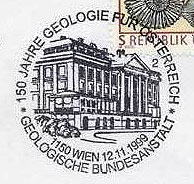Austria 1999
"150th anniversary of the Federal Geological Institute" (The Geological Survey of Austria)
| Issue Date |
12.11.1999 |
| ID |
Michel: 2298,
Scott: 1801,
Stanley Gibbons: 2548,
Yvert et Tellier: 2127,
Category: pF |
| Designer |
Design: Maria Siegl Artist:
Wolfgang Seidel |
| Stamps in set |
1 |
| Value |
s7 - Building, fossils, from left to
right: ammonite Anolcites furcosus,
gastropod Oolitica solitaria,
ammonite Heraclites robustus.
|
| Emission/Type |
commemorative |
| Issue place |
Vienna |
| Size (width x height) |
42mm x 35mm |
| Layout |
Sheet of 50 (5x10) |
| Products |
FDC x1 |
| Paper |
|
| Perforation |
13 x 13 |
| Print Technique |
Lithography + photogravure, multicolor |
| Printed by |
Österreichische Staatsdruckerei |
| Quantity |
2,800,000 |
| Issuing Authority |
Post of Austria |
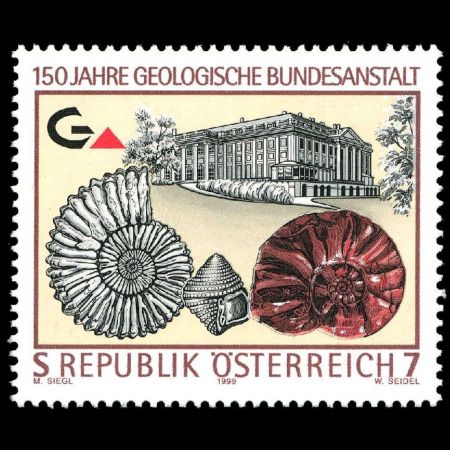
On 12
th November, 1999, the Post of Austria, issued the stamp
"150
th anniversary of the Federal Geological Institute" (The Geological Survey of Austria).
In the early 1840s, the mineral collections of the Royal and Imperial Court for Coinage and
Mining was converted into the Royal and Imperial Museum of Coal and Steel through the support of Wilhelm
Haidinger.
The Imperial Academy of Sciences was founded in 1846.
Even in those days a larger institute for the specific research of geologic conditions throughout the
empire was already under consideration.
The Geological Survey of Austria, founded in November 1849, represents the geo-management of the public
sector of Austria.
It is a government organization affiliated to the Federal Ministry of Science, Education and Arts.
Its activities are based on the National Law of Research of 2000. Presently its staff comprises 45
scientists with university degree, 34 nonscientists and a fluctuating number of non-government personnel
(around 40).
According to its mandate, the Survey undertakes the following core programmes:
- Geoscientific mapping of the Austrian territory at various scales
- Complementary mission-orientated basic research in biostratigraphy, geochronology and structural geology
- Collection and storage of unique types of rocks, minerals and fossils
- Monitoring the environment
- Administration and management of the most comprehensive geoscientific library of Austria
- Maintenance of related databases and voluminous archives of maps and unpublished reports collected over
the past 150 years
- Source of advice and information in Earth Science to the government, local authorities, industry and the
public in general
Traditional and applied tasks include such topics as
- Assessment and sustainable development of raw materials and industrial minerals
- Water management
- Natural hazard mitigation in Alpine terrains
- Feasibility studies for major civil engineering projects
- Contamination and waste deposal studies
- Nature conservation and land use planning
- Networking in global change programmes
- Membership in EuroGeoSurveys, Forum of European Geological Surveys and other international
organizations
Products and associated philatelic items
| FDC |
Maxi Card |
Example of circulated letters |
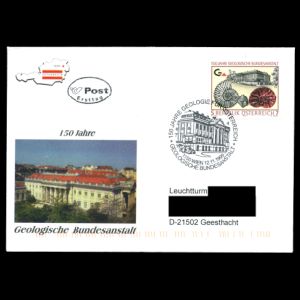 |
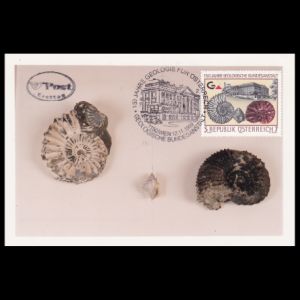 |
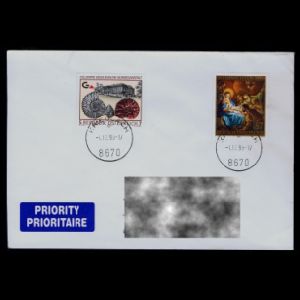 |
|
| Specimen |
First-Day-of-Issue Postmark |
Information Brochure (PDF, in German) |
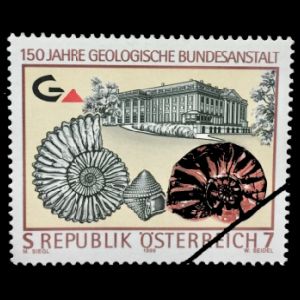 |
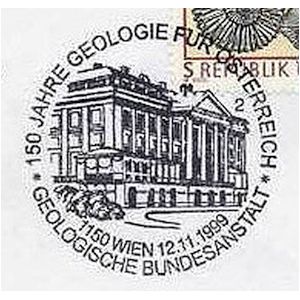 |
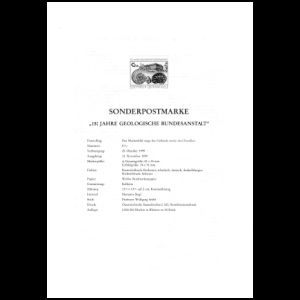 |
References
reverse side of an FDC,
Wikipedia,
Federal Geological Institute of Austria.
Acknowledgements
Many thanks to
Dr.
Peter Voice from Department of Geological and Environmental Sciences, Western Michigan University, for his help to find an information for this article,
the draft page review and his very valuable comments.

